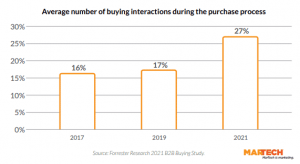“Big data really is about having insights and making an impact on your business. If you aren’t taking advantage of the data you’re collecting, then you just have a pile of data, you don’t have big data.”
Believe it or not, these words were spoken by Facebook’s VP of Infrastructure Engineering Jay Parikh three years ago now. Yet as marketers everywhere continue to collect as much consumer data as possible, they still seem to be winding up with a big pile of data – a far cry from the actionable insights they hope to glean.
According to Bizo’s recent Data-Driven Marketer survey, only 20% of marketers believe that, when it comes to using data, they are “doing well” or have “nailed it.”

So what’s the best way to classify the data you collect, and what do you do with it? Better yet, how do you transform a “pile of data” into an actual representation of your current and potential customers? Here are three key types of data that your business should be collecting and leveraging, and how to make them work together to truly understand your customers.
Demographic Data
Types of demographic data include: email, zip code, gender, birthday, phone number, marital status, age, income and more. Demographic data is probably the easiest data to collect, as each demographic data field within a marketing database typically has only one corresponding entry.
It is also the data that marketers seem the most comfortable with leveraging across campaigns. In fact, the majority of marketers primarily rely on names (55%) and demographic information (53%) to personalize campaigns, while less than a third use consumer interests, transaction and event triggers, or consumer interactions with brands (Infogroup).
How to Use It: When fans log in socially to Hunter Hayes’ website, they are asked to provide their birthdays. This information is stored and passed to an email marketing platform that automatically dispatches birthday emails to fans on their special days, offering a celebratory birthday discount.
Interest Data
Interest data refers to users’ favorite brands, television shows, movies, music artists and more, and is one of the most powerful types of marketing information available. Insight into user preferences enables businesses to create an unprecedented level of relevance for existing customers, as well as understand the types of new users they should be targeting.
Typically captured across social networks and other public consumer channels, interest data comes in many forms, such as Facebook Likes. Effectively managing interest data requires a dynamic schema database with the ability to make sense of all types of user information and present it in a way that marketers can understand and use. This system must also be up to par when it comes to managing the privacy regulations of these third-party sources.
How to Use It: By capturing the interests of users logging into its site via Facebook, the Canadian Olympic Committee discovered that its users shared interests in Canadian hockey teams, particular gaming apps and TV shows like the Big Bang Theory. The committee was then able to create look-alike target segments to reach similar users on Facebook that were most likely to convert. This resulted in a 106% increase in conversion rates!

Behavioral Data
A clear understanding of the actions users are taking on your site can lead to highly optimized paths of conversion – if you’re monitoring the right types of behaviors. Behavioral data can include page visits, clicks, purchases, social shares, comments and much more.
Unfortunately, many brands miss the boat when it comes to capturing meaningful user behaviors because they fail to give users enough opportunities to engage on-site. For example, providing customers with the ability to leave reviews is critical for eCommerce brands looking to measure retention, while publishing brands attempting to cater content to their audience should implement comments and social sharing.
How to Use It: With the ability to port users’ on-site behaviors directly into Marketo for use in email marketing campaigns, Learn Liberty is able to trigger highly relevant and timely emails based on particular site activity. For example, if a subscriber visits three job opportunities in one day, he or she is automatically placed into a Marketo job alert campaign. Since implementing this data integration, site referral traffic from Marketo email campaigns has increased by 152%!
See People – Not Data
To manage these and other data types effectively, marketers must move beyond anonymous and siloed user data to create known, unified profiles that power 1:1 customer relationships. The key to making this happen? Identity.
By identifying site visitors at the point of site entry via registration and social login, marketers can tie demographic, interest and behavioral data to individual user identities. This enables brands to personalize user experiences on an individual level – even as users move across channels and devices. What’s more, identity data is permission-based and captured directly from your users, resulting in more accurate and complete information that leads to more effective segmentation.
For more information on how to effectively manage your user data by putting customer identity at the center of your marketing strategy, download our free white paper, Making Sense of Customer Data.
(310)





